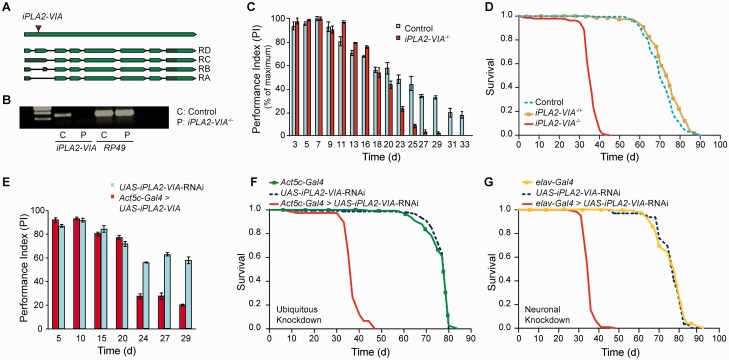Figure 1.
Lack of iPLA2-VIA gene activity leads to reduced survival and locomotor deficits. (A) Schematic of the Drosophila iPLA2-VIA gene, showing the position of the P-element insertion (arrowhead). The iPLA2-VIA gene has four main transcripts: iPLA2-VIA-RB, iPLA2-VIA-RC, iPLA2-VIA-RD and iPLA2-VIA-RA (FlyBase). The position of the primers has been previously shown (Malhotra et al., 2009). (B) RT-PCR analysis of iPLA2-VIA−/− flies shows that there is no mRNA expression of the iPLA2-VIA gene compared with w1118 control flies. The end products of the RT-PCR reaction were run on an agarose gel. RP49 is an internal control gene and is expressed in both the iPLA2-VIA−/− and control w1118 flies. (C) iPLA2-VIA−/− flies display an age-dependent reduction in climbing ability compared with w1118 controls (n = 45 flies per genotype, three repeats per genotype, P < 0.05). Climbing ability is expressed as a perfomance index (PI) over time in days (d). (D) Female flies lacking both iPLA2-VIA genes (iPLA2-VIA−/−) have a significantly reduced lifespan compared with w1118 control flies (P < 0.0001). Furthermore female flies lacking only one iPLA2-VIA gene (iPLA2-VIA+/−; n = 150 flies per genotype) do not display a reduction in lifespan. (E) Ubiquitous downregulation of iPLA2-VIA activity using sRNAi (UAS-iPLA2-VIA-RNAi) driven by Act5c-Gal4 (Act5c-Gal4 > UAS-iPLA2-VIA-RNAi) results in an age-dependent reduction in climbing ability compared with control UAS-iPLA2-VIA-RNAi flies (P < 0.05; n = 45 flies per genotype, three repeats each). (F) Knockdown of iPLA2-VIA activity using iPLA2-VIA sRNAi (UAS-iPLA2-VIA-RNAi) driven ubiquitously by Act5c-Gal4 (Act5c-Gal4 > UAS-iPLA2-VIA-RNAi) results in a decrease in lifespan compared with control non-expressing UAS-iPLA2-VIA-RNAi flies (P < 0.0001) or driver Act5c-Gal4 flies (P < 0.0001), similar to that seen with the null mutant flies (iPLA2-VIA−/−; n = 150 flies per genotype). (G) Knockdown of iPLA2-VIA activity using sRNAi (UAS-iPLA2-VIA-RNAi) driven in the fly nervous system using the elav-Gal4 driver results in a decrease in lifespan compared with control non-expressing UAS-iPLA2-VIA-RNAi flies (P < 0.0001), or driver elav-Gal4 (P < 0.0001; n = 150 flies per genotype), similar to that seen with the null mutant flies (iPLA2-VIA−/−).

